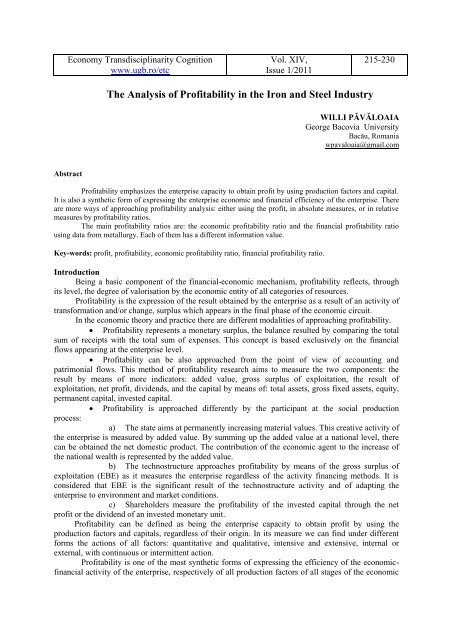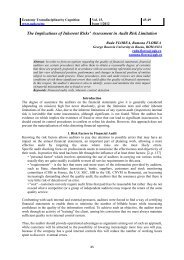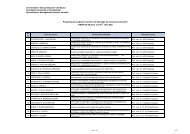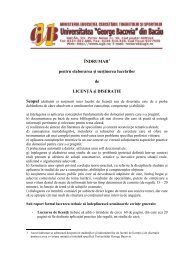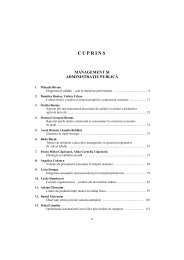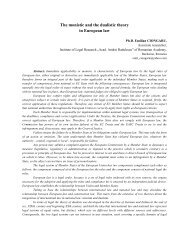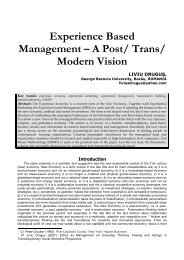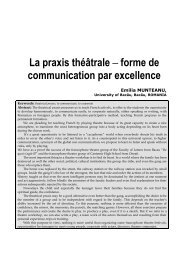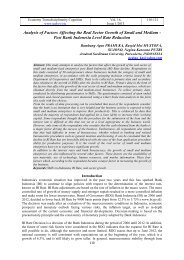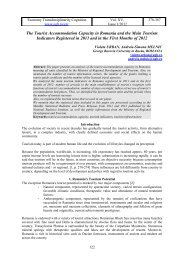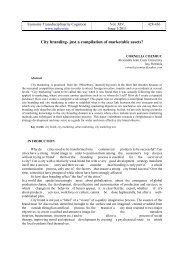The Analysis of Profitability in the Iron and Steel Industry
The Analysis of Profitability in the Iron and Steel Industry
The Analysis of Profitability in the Iron and Steel Industry
You also want an ePaper? Increase the reach of your titles
YUMPU automatically turns print PDFs into web optimized ePapers that Google loves.
Economy Transdiscipl<strong>in</strong>arity Cognitionwww.ugb.ro/etcVol. XIV,Issue 1/2011215-230<strong>The</strong> <strong>Analysis</strong> <strong>of</strong> Pr<strong>of</strong>itability <strong>in</strong> <strong>the</strong> <strong>Iron</strong> <strong>and</strong> <strong>Steel</strong> <strong>Industry</strong>WILLI PĂVĂLOAIAGeorge Bacovia UniversityBacău, Romaniawpavaloaia@gmail.comAbstractPr<strong>of</strong>itability emphasizes <strong>the</strong> enterprise capacity to obta<strong>in</strong> pr<strong>of</strong>it by us<strong>in</strong>g production factors <strong>and</strong> capital.It is also a syn<strong>the</strong>tic form <strong>of</strong> express<strong>in</strong>g <strong>the</strong> enterprise economic <strong>and</strong> f<strong>in</strong>ancial efficiency <strong>of</strong> <strong>the</strong> enterprise. <strong>The</strong>reare more ways <strong>of</strong> approach<strong>in</strong>g pr<strong>of</strong>itability analysis: ei<strong>the</strong>r us<strong>in</strong>g <strong>the</strong> pr<strong>of</strong>it, <strong>in</strong> absolute measures, or <strong>in</strong> relativemeasures by pr<strong>of</strong>itability ratios.<strong>The</strong> ma<strong>in</strong> pr<strong>of</strong>itability ratios are: <strong>the</strong> economic pr<strong>of</strong>itability ratio <strong>and</strong> <strong>the</strong> f<strong>in</strong>ancial pr<strong>of</strong>itability ratious<strong>in</strong>g data from metallurgy. Each <strong>of</strong> <strong>the</strong>m has a different <strong>in</strong>formation value.Key-words: pr<strong>of</strong>it, pr<strong>of</strong>itability, economic pr<strong>of</strong>itability ratio, f<strong>in</strong>ancial pr<strong>of</strong>itability ratio.IntroductionBe<strong>in</strong>g a basic component <strong>of</strong> <strong>the</strong> f<strong>in</strong>ancial-economic mechanism, pr<strong>of</strong>itability reflects, throughits level, <strong>the</strong> degree <strong>of</strong> valorisation by <strong>the</strong> economic entity <strong>of</strong> all categories <strong>of</strong> resources.Pr<strong>of</strong>itability is <strong>the</strong> expression <strong>of</strong> <strong>the</strong> result obta<strong>in</strong>ed by <strong>the</strong> enterprise as a result <strong>of</strong> an activity <strong>of</strong>transformation <strong>and</strong>/or change, surplus which appears <strong>in</strong> <strong>the</strong> f<strong>in</strong>al phase <strong>of</strong> <strong>the</strong> economic circuit.In <strong>the</strong> economic <strong>the</strong>ory <strong>and</strong> practice <strong>the</strong>re are different modalities <strong>of</strong> approach<strong>in</strong>g pr<strong>of</strong>itability. Pr<strong>of</strong>itability represents a monetary surplus, <strong>the</strong> balance resulted by compar<strong>in</strong>g <strong>the</strong> totalsum <strong>of</strong> receipts with <strong>the</strong> total sum <strong>of</strong> expenses. This concept is based exclusively on <strong>the</strong> f<strong>in</strong>ancialflows appear<strong>in</strong>g at <strong>the</strong> enterprise level. Pr<strong>of</strong>itability can be also approached from <strong>the</strong> po<strong>in</strong>t <strong>of</strong> view <strong>of</strong> account<strong>in</strong>g <strong>and</strong>patrimonial flows. This method <strong>of</strong> pr<strong>of</strong>itability research aims to measure <strong>the</strong> two components: <strong>the</strong>result by means <strong>of</strong> more <strong>in</strong>dicators: added value, gross surplus <strong>of</strong> exploitation, <strong>the</strong> result <strong>of</strong>exploitation, net pr<strong>of</strong>it, dividends, <strong>and</strong> <strong>the</strong> capital by means <strong>of</strong>: total assets, gross fixed assets, equity,permanent capital, <strong>in</strong>vested capital. Pr<strong>of</strong>itability is approached differently by <strong>the</strong> participant at <strong>the</strong> social productionprocess:a) <strong>The</strong> state aims at permanently <strong>in</strong>creas<strong>in</strong>g material values. This creative activity <strong>of</strong><strong>the</strong> enterprise is measured by added value. By summ<strong>in</strong>g up <strong>the</strong> added value at a national level, <strong>the</strong>recan be obta<strong>in</strong>ed <strong>the</strong> net domestic product. <strong>The</strong> contribution <strong>of</strong> <strong>the</strong> economic agent to <strong>the</strong> <strong>in</strong>crease <strong>of</strong><strong>the</strong> national wealth is represented by <strong>the</strong> added value.b) <strong>The</strong> technostructure approaches pr<strong>of</strong>itability by means <strong>of</strong> <strong>the</strong> gross surplus <strong>of</strong>exploitation (EBE) as it measures <strong>the</strong> enterprise regardless <strong>of</strong> <strong>the</strong> activity f<strong>in</strong>anc<strong>in</strong>g methods. It isconsidered that EBE is <strong>the</strong> significant result <strong>of</strong> <strong>the</strong> technostructure activity <strong>and</strong> <strong>of</strong> adapt<strong>in</strong>g <strong>the</strong>enterprise to environment <strong>and</strong> market conditions.c) Shareholders measure <strong>the</strong> pr<strong>of</strong>itability <strong>of</strong> <strong>the</strong> <strong>in</strong>vested capital through <strong>the</strong> netpr<strong>of</strong>it or <strong>the</strong> dividend <strong>of</strong> an <strong>in</strong>vested monetary unit.Pr<strong>of</strong>itability can be def<strong>in</strong>ed as be<strong>in</strong>g <strong>the</strong> enterprise capacity to obta<strong>in</strong> pr<strong>of</strong>it by us<strong>in</strong>g <strong>the</strong>production factors <strong>and</strong> capitals, regardless <strong>of</strong> <strong>the</strong>ir orig<strong>in</strong>. In its measure we can f<strong>in</strong>d under differentforms <strong>the</strong> actions <strong>of</strong> all factors: quantitative <strong>and</strong> qualitative, <strong>in</strong>tensive <strong>and</strong> extensive, <strong>in</strong>ternal orexternal, with cont<strong>in</strong>uous or <strong>in</strong>termittent action.Pr<strong>of</strong>itability is one <strong>of</strong> <strong>the</strong> most syn<strong>the</strong>tic forms <strong>of</strong> express<strong>in</strong>g <strong>the</strong> efficiency <strong>of</strong> <strong>the</strong> economicf<strong>in</strong>ancialactivity <strong>of</strong> <strong>the</strong> enterprise, respectively <strong>of</strong> all production factors <strong>of</strong> all stages <strong>of</strong> <strong>the</strong> economic
circuit: supply, production, sales for analysis for which two groups <strong>of</strong> <strong>in</strong>dicators are used: pr<strong>of</strong>it(absolute measure) <strong>and</strong> pr<strong>of</strong>itability rates (relative measures).1. Pr<strong>of</strong>it <strong>Analysis</strong>Without be<strong>in</strong>g <strong>the</strong> ma<strong>in</strong> purpose <strong>of</strong> <strong>the</strong> activity, pr<strong>of</strong>it has an important signification for <strong>the</strong>economic agent, duet to its functions: source <strong>of</strong> self-f<strong>in</strong>anc<strong>in</strong>g, lever <strong>of</strong> material co-<strong>in</strong>terest foremployees, spr<strong>in</strong>g <strong>of</strong> <strong>the</strong> formation <strong>of</strong> <strong>the</strong> sources for <strong>the</strong> activity development <strong>in</strong> normal conditions.Pr<strong>of</strong>it is <strong>the</strong> expression <strong>of</strong> pr<strong>of</strong>itability <strong>in</strong> absolute measure. <strong>The</strong>re are more models for <strong>the</strong> pr<strong>of</strong>itanalysis <strong>and</strong> calculus <strong>in</strong> <strong>the</strong> specialized literature.<strong>The</strong> data basis necessary for <strong>the</strong> analysis <strong>of</strong> pr<strong>of</strong>itability is presented <strong>in</strong> table 1.Table 1. Data basis for <strong>the</strong> analysis <strong>of</strong> pr<strong>of</strong>itability <strong>in</strong>- mii lei-No. Elements <strong>of</strong> calculus Research periodn n+1 n+21 Arcelormittal Hunedoara Total assets 268307 260756 274177Work<strong>in</strong>g assets 23992 23510 16157Equity 232692 216296 188065Total debts 266710 261155 231727Total <strong>in</strong>come 634280 766042 655512Turnover 746541,1 766042,3 655512,0Total expenses 611755 817892 653326Gross pr<strong>of</strong>it 22525 - 51850 2186Net pr<strong>of</strong>it 18905 - 1836Tax on pr<strong>of</strong>it 3620 - 3502 Arcelormittal Galaţi Total assets 2933530 2691301 2567554Work<strong>in</strong>g assets 323014 363412 404175Equity 4978385 4616647 5279067Total debts 1103312 1566032 1139805Total <strong>in</strong>come 6485004 7643573 8903051Turnover 6485005 7643573,9 8903051,8Total expenses 6277991 7225665 8145205Gross pr<strong>of</strong>it 207013 407908 757846Net pr<strong>of</strong>it 173891 324779 604871Tax on pr<strong>of</strong>it 33122 93129 1529753 TMK Reşiţa Total assets 402524 485769 532103Work<strong>in</strong>g assets 86976 100409 110578Equity 268810 297255 358127Total debts 217623 281095 280660Total <strong>in</strong>come 463483,6 555208,3 570779,7Turnover 463483 555208 570779Total expensesGross pr<strong>of</strong>it 449405 525595 513383Net pr<strong>of</strong>it 14078 29613 57396Tax on pr<strong>of</strong>it 14078 29613 57396Total assets - - -I TOTAL METALPRODUCTIONTotal assets 3664361 3437826 3373834Work<strong>in</strong>g assets 433912 483331 530919Equity 5479887 5130198 5825259Total debts 1587645 2180282 1652192Total <strong>in</strong>come 7582767 8964823 10129342Turnover 7695029,7 8964824,5 10129343,5Total expenses 7339171 8569152 9311914
4 Arcelormittal ProductsRomanGross pr<strong>of</strong>it 243596 395671 817428Net pr<strong>of</strong>it 204621 332364 686640Tax on pr<strong>of</strong>it 38975 63307 130788Total assets 143415 392102 364977Work<strong>in</strong>g assets 35144 31788 42216Equity 57398 258582 74980Total debts 403901 418566 674919Total <strong>in</strong>come 982175 903885 884598Turnover 982878,8 903885,2 884598,3Total expenses 973045 942592 1068197Gross pr<strong>of</strong>it 9130 -38707 -183599Net pr<strong>of</strong>it 8147 - -Tax on pr<strong>of</strong>it 983 - -5 Arcelormittal Products Iaşi Total assets 44339 132218 135321Work<strong>in</strong>g assets 6561 8161 7238Equity 31561 35542 161039Total debts 130071 174313 44889Total <strong>in</strong>come 230354 208308 279818Turnover 230354,7 208308,5 279818,1Total expenses 239485 236053 281174Gross pr<strong>of</strong>it -9130 -27745 -1356Net pr<strong>of</strong>it - - -Tax on pr<strong>of</strong>it - - -6 Arcelormittal Products Galaţi Total assets 23388 19846 17683Work<strong>in</strong>g assets 12929 2400 5212Equity 17 5042 9267Total debts - 48214 71068Total <strong>in</strong>come - 86620 105840Turnover - 86620,3 105840,2Total expenses - 91280 102066Gross pr<strong>of</strong>it - -4660 3774Net pr<strong>of</strong>it - -Tax on pr<strong>of</strong>it - -IITOTAL PRODUCTION OFSTEEL TUBESTotal assets 211142 544166 517981Work<strong>in</strong>g assets 54634 42349 54666Equity 88976 299166 245286Total debts 533972 641093 790876Total <strong>in</strong>come 1212529 1198813 1270256Turnover 1213233,5 1198814.0 1270256,6Total expenses 1212530 1269925 1451437Gross pr<strong>of</strong>it - -71112 -181181Net pr<strong>of</strong>it - - -Tax on pr<strong>of</strong>it - - -GENERAL TOTAL (I +II) Total assets 3875503 3981992 3891815Work<strong>in</strong>g assets 488546 525680 585585Equity 5568863 5429364 6070545Total debts 2121617 2821375 2443068Total <strong>in</strong>come 8795296 10163636 11399598Turnover 8908263,2 10163638,5 11399600,1Total expenses 8551701 9839077 10763351Gross pr<strong>of</strong>it 243595 324599 636247Net pr<strong>of</strong>it 204620 272663 534448Tax on pr<strong>of</strong>it 38975 51936 101799
One <strong>of</strong> <strong>the</strong> most used models is based on <strong>the</strong> data <strong>of</strong>fered by <strong>the</strong> pr<strong>of</strong>it <strong>and</strong> loss account,component <strong>of</strong> <strong>the</strong> annual f<strong>in</strong>ancial statements, which group <strong>in</strong>comes <strong>and</strong> revenues accord<strong>in</strong>g to <strong>the</strong>irnature. Accord<strong>in</strong>g to it, <strong>the</strong> account<strong>in</strong>g net pr<strong>of</strong>it,Pn = V – (Ch + Ip), where:Pn – net pr<strong>of</strong>it;V – total revenues;Ch – total expenses;Ip – tax on pr<strong>of</strong>it;<strong>The</strong> factorial study <strong>of</strong> <strong>the</strong> pr<strong>of</strong>it is as follows:Δ = Pn 1 – Pn 0 = [V 1 – (Ch 1 + Ip 1 )] – [V 0 - (Ch 0 + Ip 0 )] = ± leiFrom <strong>the</strong> relation <strong>of</strong> calculus <strong>the</strong>re results that <strong>the</strong>re are three factors generat<strong>in</strong>g this situation:Change <strong>of</strong> total revenues (Δ V)Change <strong>of</strong> total expenses (Δ Ch)Change <strong>of</strong> tax on pr<strong>of</strong>it (Δ Ip)<strong>The</strong> calculus <strong>of</strong> <strong>the</strong> <strong>in</strong>fluence on <strong>the</strong> modification <strong>of</strong> each factor is realised as follows:1. <strong>The</strong> <strong>in</strong>fluence <strong>of</strong> <strong>the</strong> modification <strong>of</strong> revenues (Δ V)Δ V = [V 1 – (Ch 0 + Ip 0 )] – [V 0 - (Ch 0 + Ip 0 )] = ± lei2. <strong>The</strong> <strong>in</strong>fluence <strong>of</strong> expense growth on <strong>the</strong> net pr<strong>of</strong>it is determ<strong>in</strong>ed by <strong>the</strong> relation:Δ Ch = [V 1 – (Ch 1 + Ip 0 )] – [V 1 - (Ch 0 + Ip 0 )] = ± lei<strong>The</strong> <strong>in</strong>crease <strong>of</strong> expenses <strong>in</strong> <strong>the</strong> present period as compared with <strong>the</strong> previous period, is basedon <strong>the</strong> modification <strong>of</strong> its components, <strong>the</strong>refore: work<strong>in</strong>g expenses, f<strong>in</strong>ancial expenses <strong>and</strong>extraord<strong>in</strong>ary expenses.<strong>The</strong>refore: Δ Ch = Δ Che + Δ Chf + Δ Chex<strong>The</strong> contribution <strong>of</strong> each component is determ<strong>in</strong>ed as follows:3. <strong>The</strong> effect <strong>of</strong> modification <strong>of</strong> tax on pr<strong>of</strong>it is calculated accord<strong>in</strong>g to <strong>the</strong> relation:Δ Ip = [V 1 – (Ch 1 + Ip 1 )] – [V 1 - (Ch 1 + Ip 0 )] = ± leiThis model <strong>of</strong> analysis allows us to calculate <strong>the</strong> sensitivity <strong>of</strong> <strong>the</strong> net result (net pr<strong>of</strong>it) <strong>in</strong>relation with <strong>the</strong> turnover (<strong>the</strong> value volume <strong>of</strong> <strong>the</strong> sales <strong>of</strong> products)Table 2. <strong>The</strong> result <strong>of</strong> <strong>the</strong> factorial analysis <strong>of</strong> <strong>the</strong> net pr<strong>of</strong>itNo. ExplanationsResearch periodn+1/n n+2/ n+11 Arcelormittal Hunedoara Total change, out <strong>of</strong> which: -77955 +53686- <strong>in</strong>come change +131762 -110530- expense change -206137 +164566- tax on pr<strong>of</strong>it change -3620 -3502 Arcelormittal Galaţi Total change, out <strong>of</strong> which: +150889 +280092- <strong>in</strong>come change +1158569 +1259478- expense change -947674 -919540- tax on pr<strong>of</strong>it change -60007 -598463 TMK Reşiţa Total change, out <strong>of</strong> which: +15535 +27783- <strong>in</strong>come change +91175 +15571- expense change -76190 +12212- tax on pr<strong>of</strong>it change - -I TOTAL METALPRODUCTIONTotal change, out <strong>of</strong> which: +127743 +354276- <strong>in</strong>come change +1382056 +1164519- expense change -1229981 -742762- tax on pr<strong>of</strong>it change -24332 -674814 Arcelormittal Products Roman Total change, out <strong>of</strong> which: -47837 -144892- <strong>in</strong>come change -78290 -19287- expense change +30453 -125605- tax on pr<strong>of</strong>it change +983 -5 Arcelormittal Products Iaşi Total change, out <strong>of</strong> which: -18614 +26389
- <strong>in</strong>come change -22046 +71510- expense change +3432 -45121- tax on pr<strong>of</strong>it change - -6 Arcelormittal Products Galaţi Total change, out <strong>of</strong> which: - +8434- <strong>in</strong>come change - +19220- expense change - -10786- tax on pr<strong>of</strong>it change - -IITOTAL PRODUCTION OFSTEEL TUBESTotal change, out <strong>of</strong> which: -71111 -110070- <strong>in</strong>come change -13716 +71443- expense change -57395 -181512- tax on pr<strong>of</strong>it change - -GENERAL TOTAL (I +II) Total change, out <strong>of</strong> which: +68003 +261825- <strong>in</strong>come change +1368340 +1235962- expense change -1287376 -924274- tax on pr<strong>of</strong>it change -12961 -49863<strong>The</strong> data from table 2 shows that as a whole <strong>the</strong> developed activity registered pr<strong>of</strong>it, moreover<strong>the</strong> net pr<strong>of</strong>it is <strong>in</strong>creased from one period to ano<strong>the</strong>r. We register, on <strong>the</strong> one h<strong>and</strong>, an <strong>in</strong>crease <strong>of</strong>revenues concretised <strong>in</strong> <strong>the</strong> supplementary pr<strong>of</strong>it <strong>of</strong> + 68.003 thous<strong>and</strong> lei <strong>in</strong> n+1 as compared to n,respectively + 261.825 thous<strong>and</strong> lei <strong>in</strong> n+2 as compared to n+1. At <strong>the</strong> same time, <strong>the</strong> <strong>in</strong>crease <strong>of</strong>expenses, <strong>in</strong> <strong>the</strong> same period <strong>of</strong> time, has generated net pr<strong>of</strong>it decreases, normal effect, <strong>and</strong> hasattracted <strong>the</strong> dim<strong>in</strong>ution <strong>of</strong> <strong>the</strong> net pr<strong>of</strong>it with 1.287.376 thous<strong>and</strong> lei <strong>in</strong> n+1 as compared to n,respectively – 924.274 thous<strong>and</strong> lei <strong>in</strong> n+2 as compared to n+1. Ano<strong>the</strong>r positive aspect is <strong>the</strong> surplus<strong>of</strong> pr<strong>of</strong>it belong<strong>in</strong>g to <strong>the</strong> researched period <strong>of</strong> time is due to <strong>the</strong> fact that, at this analysis level, <strong>the</strong>rehas been observed <strong>the</strong> correlation between <strong>the</strong> growth rhythm <strong>of</strong> revenues <strong>and</strong> that <strong>of</strong> expenses. <strong>The</strong>surplus <strong>of</strong> net pr<strong>of</strong>it was due to <strong>the</strong> fact that <strong>the</strong> growth rhythm <strong>of</strong> revenues has advanced <strong>the</strong> expensesgrowth rhythm.For <strong>the</strong> two sectors <strong>of</strong> activity, <strong>the</strong> production <strong>of</strong> metal <strong>and</strong> <strong>the</strong> production <strong>of</strong> tubes, <strong>the</strong>evolution <strong>of</strong> <strong>the</strong> net pr<strong>of</strong>it is different. <strong>The</strong> societies compos<strong>in</strong>g <strong>the</strong> production <strong>of</strong> metals developpr<strong>of</strong>itable activities (see table 1) <strong>and</strong> <strong>the</strong> net pr<strong>of</strong>it has <strong>in</strong>creased from year to year. <strong>The</strong> activity <strong>of</strong> <strong>the</strong>components <strong>of</strong> steel tubes production registered losses, <strong>the</strong> net loss <strong>in</strong>creased <strong>in</strong> <strong>the</strong> research period.2. <strong>The</strong> <strong>Analysis</strong> <strong>of</strong> Pr<strong>of</strong>itability RatiosPr<strong>of</strong>it gives a general orientation on <strong>the</strong> activity <strong>of</strong> an economic agent, mean<strong>in</strong>g that revenuesare higher than expenses. <strong>The</strong>refore, it doesn’t always show <strong>the</strong> effort made for obta<strong>in</strong><strong>in</strong>g <strong>the</strong>se results,as <strong>the</strong>re can be economic agents with similar pr<strong>of</strong>ile, with a different volume <strong>of</strong> activity <strong>and</strong> whichobta<strong>in</strong> <strong>the</strong> same pr<strong>of</strong>it, as measure. This is <strong>the</strong> reason pr<strong>of</strong>itability is also analysed <strong>in</strong> relativemeasures, by means <strong>of</strong> pr<strong>of</strong>itability ratios.Pr<strong>of</strong>itability ratio is def<strong>in</strong>ed as <strong>the</strong> proportion between an <strong>in</strong>dicator <strong>of</strong> results <strong>and</strong> a measurereflect<strong>in</strong>g a flow <strong>of</strong> activity or a stock measure:ResultR 100Stock or activity flow‣ <strong>The</strong> pr<strong>of</strong>itability ratio is a relative measure express<strong>in</strong>g <strong>the</strong> degree <strong>in</strong> which capital as a wholebr<strong>in</strong>gs pr<strong>of</strong>it.‣ In <strong>the</strong> whole <strong>of</strong> economic-f<strong>in</strong>ancial <strong>in</strong>dicators <strong>the</strong> pr<strong>of</strong>itability ratio is placed among <strong>the</strong> mostsyn<strong>the</strong>tic efficiency <strong>in</strong>dicators <strong>of</strong> <strong>the</strong> enterprise activity 1 .‣ In <strong>the</strong> level <strong>of</strong> pr<strong>of</strong>itability ratios <strong>the</strong>re are reflected <strong>the</strong> results <strong>of</strong> <strong>the</strong> enterprise activity <strong>of</strong> allstages <strong>of</strong> <strong>the</strong> economic circuit. In comparison with costs, which reflect <strong>the</strong> results <strong>in</strong> <strong>the</strong>production stage, <strong>the</strong> pr<strong>of</strong>itability ratio syn<strong>the</strong>sises those from <strong>the</strong> distribution stage.
‣ <strong>The</strong> pr<strong>of</strong>itability ratios, as compared with <strong>the</strong> pr<strong>of</strong>it, allow <strong>the</strong> realisation <strong>of</strong> comparativeanalysis <strong>in</strong> space, between similar units, but with a different volume <strong>of</strong> activity.As <strong>the</strong> registered result can be expressed by: <strong>the</strong> result <strong>of</strong> exploitation, added value, grosssurplus <strong>of</strong> exploitation, gross pr<strong>of</strong>it, net pr<strong>of</strong>it, operational pr<strong>of</strong>it, dividends; flow <strong>of</strong> activity by:turnover, consumed resources, <strong>and</strong> <strong>the</strong> stock measure by: equity, permanent capital, total assets, fixedassets, <strong>the</strong>re results a great diversity <strong>of</strong> models that can be used <strong>in</strong> order to analyse <strong>the</strong> pr<strong>of</strong>itabilityratios <strong>of</strong> an economic agent.Accord<strong>in</strong>g to <strong>the</strong> reference basis, <strong>the</strong> pr<strong>of</strong>itability ratio acquires content <strong>and</strong> different forms. Weshall present here some <strong>of</strong> <strong>the</strong> models used <strong>in</strong> pr<strong>of</strong>itability analysis.2.1. <strong>The</strong> <strong>Analysis</strong> <strong>of</strong> Economic Pr<strong>of</strong>itability Ratio<strong>The</strong> economic pr<strong>of</strong>itability ratio measures <strong>the</strong> performances <strong>of</strong> <strong>the</strong> enterprise total assets, <strong>of</strong> <strong>the</strong><strong>in</strong>vested capital, respectively, without tak<strong>in</strong>g <strong>in</strong>to consideration <strong>the</strong> modalities <strong>of</strong> obta<strong>in</strong><strong>in</strong>g <strong>the</strong>capitals. As a result, its measure is not <strong>in</strong>fluenced by <strong>the</strong> enterprise f<strong>in</strong>anc<strong>in</strong>g policy.<strong>The</strong> most used model <strong>of</strong> calculus is:Pba) Re 100, where:APb – gross pr<strong>of</strong>it;A – economic assets .This calculus formula expresses <strong>the</strong> pr<strong>of</strong>itability <strong>of</strong> <strong>the</strong> total assets.From <strong>the</strong> calculus ratio <strong>the</strong>re results that <strong>the</strong> economic pr<strong>of</strong>itability ratio measures:▪ <strong>the</strong> degree <strong>of</strong> valorisation <strong>of</strong> <strong>the</strong> <strong>in</strong>vested capital, express<strong>in</strong>g gross pr<strong>of</strong>it <strong>in</strong> lei at an <strong>in</strong>vestedcapital unit;▪ <strong>the</strong> performance <strong>of</strong> <strong>the</strong> enterprise assets , regardless <strong>of</strong> its way <strong>of</strong> f<strong>in</strong>anc<strong>in</strong>g (equity, foreigncapital) <strong>and</strong> <strong>of</strong> <strong>the</strong> fiscal system;▪ <strong>the</strong> efficiency <strong>of</strong> <strong>the</strong> material <strong>and</strong> f<strong>in</strong>ancial means allotted to <strong>the</strong> ma<strong>in</strong> activity (exploitation <strong>and</strong>commercial);For economical reasons, <strong>the</strong> level <strong>of</strong> economic pr<strong>of</strong>itability ratio has to meet <strong>the</strong> follow<strong>in</strong>gconditions:▪ <strong>the</strong> level <strong>of</strong> economic pr<strong>of</strong>itability ratio must ensure <strong>the</strong> keep<strong>in</strong>g <strong>of</strong> <strong>the</strong> unit’s economicsubstance. This is realised only if <strong>the</strong> economic pr<strong>of</strong>itability ratio is higher than <strong>the</strong> <strong>in</strong>flation rate;▪ <strong>the</strong> economic pr<strong>of</strong>itability ratio must assure <strong>the</strong> remuneration <strong>of</strong> <strong>the</strong> <strong>in</strong>vested capital at <strong>the</strong> level<strong>of</strong> <strong>the</strong> m<strong>in</strong>imum rate <strong>of</strong> output <strong>in</strong> economy (<strong>the</strong> medium <strong>in</strong>terest rate) <strong>and</strong> to cover at <strong>the</strong> same time <strong>the</strong>economic <strong>and</strong> f<strong>in</strong>ancial risk <strong>of</strong> <strong>in</strong>vestors;▪ to assure <strong>the</strong> fructification <strong>of</strong> <strong>the</strong> lever effect <strong>of</strong> <strong>the</strong> enterprise gear<strong>in</strong>g <strong>and</strong> it is realised onlywhen <strong>the</strong> economic pr<strong>of</strong>itability is superior to <strong>the</strong> <strong>in</strong>terest rate.In <strong>the</strong> analysis <strong>of</strong> this rate <strong>the</strong>re can be used more models based on <strong>the</strong> decompos<strong>in</strong>g <strong>of</strong> <strong>the</strong><strong>in</strong>itial model <strong>in</strong>to rates structured accord<strong>in</strong>g to different criteria.Operat<strong>in</strong>g a ma<strong>the</strong>matical artifice, <strong>the</strong> <strong>in</strong>itial relation can be written as follows:Pb CAb) Re 100, where CA – turnover, orCA ARe = Gross marg<strong>in</strong> Assets rotation, that is, Re = Mb VrThis relation shows that <strong>the</strong> same result can be obta<strong>in</strong>ed through two different commercialpolicies:- a quality policy <strong>of</strong> products will generate a great pr<strong>of</strong>it marg<strong>in</strong>, but with a weakrotation <strong>of</strong> sales;- Or a policy <strong>of</strong> low prices, with a low pr<strong>of</strong>it marg<strong>in</strong>, but with a great rotation <strong>of</strong>sales.Δ = Re 1 – Re 0 = Mb 1 Vr 1 - Mb 0 Vr 0 = ± %<strong>The</strong> total modification is expla<strong>in</strong>ed by:1. <strong>The</strong> <strong>in</strong>fluence <strong>of</strong> <strong>the</strong> gross marg<strong>in</strong> modification:Δ Mb = Mb 1 Vr 0 - Mb 0 Vr 0 = ± %2. <strong>The</strong> <strong>in</strong>fluence <strong>of</strong> assets rotation modification:
Δ Vr = Mb 1 Vr 1 - Mb 1 Vr 0 = ± %▪ <strong>the</strong> growth <strong>of</strong> <strong>the</strong> gross marg<strong>in</strong> can be realised by:- <strong>the</strong> <strong>in</strong>crease <strong>of</strong> <strong>the</strong> physical volume <strong>of</strong> manufactured <strong>and</strong> delivered production,- <strong>the</strong> reduction <strong>of</strong> production (operat<strong>in</strong>g) expenses,- <strong>the</strong> modification <strong>of</strong> <strong>the</strong> production structure <strong>in</strong> favour <strong>of</strong> <strong>the</strong> products that have a greaterpr<strong>of</strong>itability,- - <strong>the</strong> <strong>in</strong>crease <strong>of</strong> production prices associated only with <strong>the</strong> improvement <strong>of</strong> <strong>the</strong>ir quality.▪ <strong>the</strong> acceleration <strong>of</strong> <strong>the</strong> rotation speed <strong>of</strong> economic assets supposes:- <strong>the</strong> reduction <strong>of</strong> stocks level <strong>and</strong> <strong>of</strong> <strong>the</strong> f<strong>in</strong>ished products delivery rotation,- <strong>the</strong> reduction <strong>of</strong> stocks level l<strong>and</strong> <strong>of</strong> <strong>the</strong> manufacture cycle rotation,- <strong>the</strong> optimization <strong>of</strong> <strong>the</strong> <strong>in</strong>vested capital structure <strong>in</strong> fixed assets <strong>and</strong> circulat<strong>in</strong>g assets,- <strong>the</strong> <strong>in</strong>crease <strong>of</strong> <strong>the</strong> active fixed assets share <strong>in</strong> <strong>the</strong> total <strong>of</strong> fixed assets,- <strong>the</strong> reduction <strong>of</strong> stocks level <strong>and</strong> <strong>of</strong> <strong>the</strong> raw materials supply duration,- <strong>the</strong> reduction <strong>of</strong> <strong>the</strong> receivables quantity <strong>and</strong> <strong>of</strong> <strong>the</strong> average duration <strong>of</strong> cash<strong>in</strong>g.. <strong>The</strong> elements necessary for <strong>the</strong> economic pr<strong>of</strong>itability ratio accord<strong>in</strong>g to b model, presentedabove, are systematised <strong>in</strong> table 3.Table 3. <strong>The</strong> calculus <strong>of</strong> <strong>the</strong> economic pr<strong>of</strong>itability ratio (model b)No. ExplanationsResearch period1 TOTALMETALPRODUCTION2 TOTALPRODUCTION OFSTEEL TUBES3 GENERALTOTAL (I +II)n n+1 n+2Gross marg<strong>in</strong> 0,0316 0,0441 0,0807Rotat<strong>in</strong>g speed 2,0999 2,6067 3,0023Economic pr<strong>of</strong>itability ratio 6,64 11,49 24,22Gross marg<strong>in</strong> - -0,0593 -0,1429Rotat<strong>in</strong>g speed - 2,2030 2,4523Economic pr<strong>of</strong>itability ratio - -13,06 -34,96Gross marg<strong>in</strong> 0,0273 0,0319 0,0558Rotat<strong>in</strong>g speed 2,2986 2,5524 2,9291Economic pr<strong>of</strong>itability ratio 6,28 8,95 16,34<strong>The</strong> data <strong>in</strong> table 3 present a differentiated evolution <strong>of</strong> <strong>the</strong> economic pr<strong>of</strong>itability ratio. It isnecessary to mention that <strong>the</strong> economic activity <strong>of</strong> this <strong>in</strong>dustrial sector, <strong>the</strong> metallurgic one, ischaracterised by: a normal level <strong>of</strong> <strong>the</strong> gross marg<strong>in</strong>, between 2.73 gross pr<strong>of</strong>it at 100 lei turnover <strong>and</strong>8.07 gross pr<strong>of</strong>it at 100 lei turnover, but also through a relatively reduced rotation speed, <strong>the</strong> recovery<strong>of</strong> assets through <strong>the</strong> turnover is realised three times per year, fact show<strong>in</strong>g that <strong>the</strong> recovery is doneapproximately after 120 days, above <strong>the</strong> accepted normal measure, that <strong>of</strong> 30 days. As such, <strong>the</strong> sectormanagement needs to give attention to: <strong>the</strong> reduction <strong>of</strong> <strong>the</strong> stocks level <strong>and</strong> <strong>of</strong> <strong>the</strong> f<strong>in</strong>ished productsdelivery duration, <strong>the</strong> reduction <strong>of</strong> <strong>the</strong> stocks level <strong>and</strong> <strong>the</strong> duration <strong>of</strong> <strong>the</strong> manufacture cycle, <strong>the</strong>reduction <strong>of</strong> receivables quantity <strong>and</strong> <strong>the</strong> average cash<strong>in</strong>g duration.<strong>The</strong> results <strong>of</strong> <strong>the</strong> factorial study <strong>of</strong> <strong>the</strong> economic pr<strong>of</strong>itability ratio are presented <strong>in</strong> table 4:Table 4. <strong>The</strong> syn<strong>the</strong>sis <strong>of</strong> <strong>the</strong> factorial analysis <strong>of</strong> <strong>the</strong> economic pr<strong>of</strong>itability ratio, model b:No. ExplanationsResearch periodn+1-n n+2- n+11 TOTAL METAL Total change, out <strong>of</strong> which: + 4,85 + 12,73PRODUCTION- gross marg<strong>in</strong> change(ΔMb) + 2,62 + 9,552 TOTAL PRODUCTIONOF STEEL TUBESGENERAL TOTAL (I+II)- assets rotation change (Δvr) + 2,23 + 3,18Total change, out <strong>of</strong> which: - - 21,9- gross marg<strong>in</strong> change(ΔMb) - - 18,35- assets rotation change (Δvr) - - 3,55Total change, out <strong>of</strong> which: + 1,87 + 8,19- gross marg<strong>in</strong> change(ΔMb) + 1,05 + 6,09- assets rotation change (Δvr) + 0,82 + 2,10
If, <strong>in</strong> total, <strong>the</strong> economic pr<strong>of</strong>itability ratio <strong>in</strong>creases from one period to ano<strong>the</strong>r, from 6.28percents <strong>in</strong> year n to 16.34 percents <strong>in</strong> year n+2, for <strong>the</strong> two components, <strong>the</strong> metal production,respectively <strong>the</strong> tubes production, <strong>the</strong> dynamics <strong>of</strong> this <strong>in</strong>dicator is different. <strong>The</strong> metal production ispr<strong>of</strong>itable, <strong>in</strong> <strong>the</strong> analysed period, <strong>the</strong> measure <strong>of</strong> <strong>the</strong> researched <strong>in</strong>dicator <strong>in</strong>creas<strong>in</strong>g almost 4 times,from 6.64 percents to 24.22 percents. <strong>The</strong> activity <strong>of</strong> <strong>the</strong> steel tubes production is not pr<strong>of</strong>itable, <strong>the</strong>pr<strong>of</strong>it losses are significant, <strong>the</strong>refore <strong>the</strong> economic pr<strong>of</strong>itability ratio has negative values <strong>and</strong><strong>in</strong>creas<strong>in</strong>g from one year to ano<strong>the</strong>r, respectively from – 13.06 percents to – 34.96 percents. We haveremarqued <strong>the</strong> follow<strong>in</strong>g positive aspects: <strong>the</strong> favourable <strong>in</strong>fluence <strong>of</strong> <strong>the</strong> gross marg<strong>in</strong> growth both fortotal <strong>and</strong> for <strong>the</strong> metal production concretized <strong>in</strong> <strong>in</strong>creas<strong>in</strong>g <strong>the</strong> economic pr<strong>of</strong>itability ratio with valuesbetween 1.05 percents <strong>and</strong> 9.55 percents; <strong>the</strong> favourable <strong>in</strong>fluence <strong>of</strong> <strong>the</strong> rotation speed accelerationwhich concretized <strong>in</strong> <strong>in</strong>creas<strong>in</strong>g this pr<strong>of</strong>itability ratio with values between 0.82 percents <strong>and</strong> 3.18percents.c) <strong>The</strong> analysis <strong>of</strong> <strong>the</strong> economic pr<strong>of</strong>itability ratio <strong>in</strong> accordance with model a can beapproached by decompos<strong>in</strong>g <strong>the</strong> assets <strong>in</strong> <strong>the</strong> component elements, fixed assets <strong>and</strong> circulat<strong>in</strong>gassets (A=Ai+Ac). <strong>The</strong>refore:PbPb PbRe 100 CA100where:A Ai Ac 1 1CAAiCAAcPb CA commercial pr<strong>of</strong>itability ratio (Rc), fixed assets output (ra),CAAiCA rotation speed <strong>of</strong> circulat<strong>in</strong>g assets (vr).Ac<strong>The</strong> methodology <strong>of</strong> factorial analysis accord<strong>in</strong>g to this model (model c) supposes <strong>the</strong>calculation <strong>of</strong> <strong>the</strong> total modification <strong>and</strong> <strong>the</strong> <strong>in</strong>fluences <strong>of</strong> <strong>the</strong> three factors modification:<strong>The</strong> modification (<strong>in</strong>crease ⁄ decrease) <strong>of</strong> <strong>the</strong> economic pr<strong>of</strong>itability ratio is rendered by <strong>the</strong>relation:Rc1Rc0 % out <strong>of</strong> which:1 1 1 1CA1CA1CA0CA0Ai1Ac1Ai0Ac01. <strong>the</strong> modification <strong>of</strong> <strong>the</strong> fixed assets productiveness (ra):Rc0Rc0Δra %1 1 1 1CA1CA0CA0CA0Ai1Ac0Ai0Ac02. <strong>the</strong> modification <strong>of</strong> circulat<strong>in</strong>g assets (vr):Rc0Rc0 vr %1 1 1 1CA1CA1CA1CA0Ai1Ac1Ai1Ac03. <strong>the</strong> modification <strong>of</strong> commercial pr<strong>of</strong>itability ratio (rc):Rc1 Rc0Rc1 Rc0 rc %1 1 At1CA1CA1CA1Ai Ac11
Table 5. Elements for <strong>the</strong> factorial analysis <strong>of</strong> <strong>the</strong> pr<strong>of</strong>itability ratio model cNo. Elements <strong>of</strong> calculusAnalysed periodn n+1 n+21 TOTAL METAL Gross pr<strong>of</strong>it 243596 395671 817428PRODUCTION Turnover 7695029,7 8964824,5 10129343,5Fixed assets 3230449 2954495 2842915Work<strong>in</strong>g assets 433912 483331 530919Total assets 3664361 3437826 3373834Rate <strong>of</strong> commercial 0,0316 0,0441 0,0807pr<strong>of</strong>itabilityFixed assets return 2,382 3,0343 3,5632 TOTALPRODUCTIONOF STEELTUBESGENERALTOTAL(I +II)Rotation speed 17,734 18,548 19,079Gross pr<strong>of</strong>it - -71112 -181181Turnover 1213233,5 1198814.0 1270256,6Fixed assets 156508 501817 463315Work<strong>in</strong>g assets 54634 42349 54666Total assets 211142 544166 517981Rate <strong>of</strong> commercial - -0,0593 -0,1426pr<strong>of</strong>itabilityFixed assets return 7,7518 2,3889 2,7416Rotation speed 22,2065 28,3079 23,2366Gross pr<strong>of</strong>it 243595 324599 636247Turnover 8908263,2 10163638,5 11399600,1Fixed assets 3386957 3456312 3306230Work<strong>in</strong>g assets 488546 525680 585585Total assets 3875503 3981992 3891815Rate <strong>of</strong> commercial 0,0273 0,0310 0,0558pr<strong>of</strong>itabilityFixed assets return 2,6301 2,9406 3,4479Rotation speed 18,234 19,3342 19,4670Us<strong>in</strong>g <strong>the</strong> above-presented methodology, <strong>the</strong> results <strong>of</strong> <strong>the</strong> factorial study, <strong>of</strong> model c, aresystematized <strong>in</strong> table 6.Table 6. <strong>The</strong> syn<strong>the</strong>sis <strong>of</strong> <strong>the</strong> factorial study <strong>of</strong> <strong>the</strong> economic pr<strong>of</strong>itability ratio, model cNo ExplanationsResearch period1 TOTAL METALPRODUCTION2TOTALPRODUCTION OFSTEEL TUBESTOTAL GENERAL(I +II)n+1/n n+2/ n+1Total change(Δ), out <strong>of</strong> which: + 4,85 +12,73-change <strong>of</strong> assets return (Δra) + 1,54 +1,69- change <strong>of</strong> work<strong>in</strong>g assets rotation +0,05 +0,06(Δvr)-change <strong>of</strong> commercial pr<strong>of</strong>itability +3,26 +10,89(Δrc)Total change(Δ), out <strong>of</strong> which: - -21,9-change <strong>of</strong> assets return (Δra) - -1,76- change <strong>of</strong> work<strong>in</strong>g assets rotation - +1,58(Δvr)-change <strong>of</strong> commercial pr<strong>of</strong>itability - -21,72(Δrc)Total change(Δ), out <strong>of</strong> which: +2,67 +7,39-change <strong>of</strong> assets return (Δra) +0,63 +0,12- change <strong>of</strong> work<strong>in</strong>g assets rotation +0,05 +0,02(Δvr)-change <strong>of</strong> commercial pr<strong>of</strong>itability +1,99 +7,25
(Δrc)<strong>The</strong> above model shows that <strong>the</strong> economic pr<strong>of</strong>itability ratio is <strong>in</strong>fluenced by specific factors:<strong>the</strong> productiveness <strong>of</strong> economic assets, <strong>the</strong> rotation speed <strong>of</strong> <strong>the</strong> circulat<strong>in</strong>g assets <strong>and</strong> <strong>the</strong> commercialpr<strong>of</strong>itability ratio.2.2. <strong>The</strong> analysis <strong>of</strong> <strong>the</strong> f<strong>in</strong>ancial pr<strong>of</strong>itability ratio<strong>The</strong> pr<strong>of</strong>itability ratio is an <strong>in</strong>dicator <strong>of</strong> great importance for managers <strong>and</strong> <strong>in</strong>vestors. For<strong>in</strong>vestors, <strong>the</strong>ir <strong>in</strong>vestment is more pr<strong>of</strong>itable when this ratio is <strong>in</strong>creas<strong>in</strong>g. On <strong>the</strong> o<strong>the</strong>r h<strong>and</strong>, if <strong>the</strong>f<strong>in</strong>ancial pr<strong>of</strong>itability ratio is higher, <strong>the</strong> enterprise is more searched by shareholders .F<strong>in</strong>ancial pr<strong>of</strong>itability expresses <strong>the</strong> ability <strong>of</strong> equity to br<strong>in</strong>g pr<strong>of</strong>it an dis calculated as aproportion between <strong>the</strong> net pr<strong>of</strong>it (Pn) <strong>and</strong> equity (Cpr).PnRf 100where:CprPn- net pr<strong>of</strong>it,Cpr- equity.This model shows that <strong>the</strong> f<strong>in</strong>ancial pr<strong>of</strong>itability ratio gas <strong>the</strong> follow<strong>in</strong>g significations: itrepresents <strong>the</strong> enterprise capacity to generate net pr<strong>of</strong>it by <strong>the</strong> equity used <strong>in</strong> <strong>the</strong> production capacity; itmeasures <strong>the</strong> productiveness <strong>of</strong> equity, that is <strong>of</strong> <strong>the</strong> f<strong>in</strong>ancial placement <strong>of</strong> <strong>the</strong> shareholders’ capital; itexpresses <strong>the</strong> shareholders’ <strong>in</strong>terests under a double aspect, on short term, by cash<strong>in</strong>g <strong>the</strong> dividends, onlong term by re<strong>in</strong>vest<strong>in</strong>g <strong>the</strong> pr<strong>of</strong>it that assures <strong>the</strong> growth <strong>of</strong> shares’ value <strong>and</strong> implicitly <strong>the</strong> creation<strong>of</strong> <strong>the</strong> possibility to <strong>in</strong>crease dividends <strong>in</strong> <strong>the</strong> next period.By <strong>the</strong> method <strong>of</strong> calculus <strong>the</strong> f<strong>in</strong>ancial pr<strong>of</strong>itability ratio emphasizes <strong>the</strong> follow<strong>in</strong>g specificconditions:▪ F<strong>in</strong>ancial pr<strong>of</strong>itability is <strong>in</strong>fluenced by <strong>the</strong> modality to obta<strong>in</strong> capitals, reason why it issensitive towards <strong>the</strong> f<strong>in</strong>ancial structure, that is <strong>the</strong> enterprise degree <strong>of</strong> gear<strong>in</strong>g,▪ <strong>the</strong> calculus <strong>of</strong> <strong>the</strong> net pr<strong>of</strong>it is <strong>in</strong>fluenced by <strong>the</strong> calculus modalities <strong>of</strong> amortisation <strong>and</strong>provisions as well as by <strong>the</strong> method <strong>of</strong> calculus <strong>of</strong> deductible <strong>and</strong> non-deductible expensesfrom <strong>the</strong> taxed mass;▪ <strong>the</strong> f<strong>in</strong>ancial pr<strong>of</strong>itability ratio has to be greater than <strong>the</strong> average <strong>in</strong>terest rate <strong>in</strong> order torender <strong>the</strong> enterprise actions more attractive.<strong>The</strong>re are more factorial models <strong>of</strong> analysis <strong>of</strong> <strong>the</strong> f<strong>in</strong>ancial pr<strong>of</strong>itability ratio.<strong>The</strong> f<strong>in</strong>ancial pr<strong>of</strong>itability ratio can be decomposed <strong>in</strong> a product <strong>of</strong> two o<strong>the</strong>r <strong>in</strong>dicators <strong>and</strong> itcan be obta<strong>in</strong>edas follows:a)where:Rf PnAtAt100or Rf pCpr At – total assets (from <strong>the</strong> balance sheet)p n – <strong>the</strong> net pr<strong>of</strong>it at a leu assets,gi –<strong>the</strong> enterprise degree <strong>of</strong> gear<strong>in</strong>g.<strong>The</strong> measures p n <strong>and</strong> gi present, <strong>in</strong> fact, <strong>the</strong> two researches <strong>and</strong> analysis directions: a first way is<strong>the</strong> economic one, <strong>and</strong> <strong>the</strong> latter is f<strong>in</strong>ancial.<strong>The</strong> ratio Pn/At measures <strong>the</strong> global pr<strong>of</strong>itability <strong>of</strong> <strong>the</strong> enterprise capital, <strong>in</strong>vested <strong>in</strong> tangible<strong>and</strong> circulat<strong>in</strong>g assets. <strong>The</strong> second ratio At/Cp characterises <strong>in</strong>directly, <strong>the</strong> enterprise degree <strong>of</strong>gear<strong>in</strong>g. This statement can be demonstrated as follows: start<strong>in</strong>g from <strong>the</strong> fundamental equality <strong>of</strong> <strong>the</strong>balance Assets=Liabilities, with reference to <strong>the</strong> f<strong>in</strong>ancial balance, <strong>the</strong>re can be written <strong>the</strong> follow<strong>in</strong>gequality: Total assets=Equity + Debts (D)At Cpr D D<strong>the</strong>n 1Cpr Cpr Cpr<strong>The</strong> ration D/Cpr expresses <strong>the</strong> enterprise gear<strong>in</strong>g degree, ratio that can generate <strong>the</strong> appearance<strong>of</strong> <strong>the</strong> f<strong>in</strong>ancial efficiency surplus or <strong>the</strong> f<strong>in</strong>ancial lever effect.n gi
<strong>The</strong> above relation shows that enterprise equity pr<strong>of</strong>itability depends on <strong>the</strong> global pr<strong>of</strong>itability<strong>of</strong> capital an don <strong>the</strong> gear<strong>in</strong>g degree.Tak<strong>in</strong>g <strong>in</strong>to accordance this model, <strong>the</strong> <strong>in</strong>crease <strong>of</strong> <strong>the</strong> f<strong>in</strong>ancial pr<strong>of</strong>itability ratio can berealised by: <strong>in</strong>creas<strong>in</strong>g <strong>the</strong> net pr<strong>of</strong>it at a leu assets <strong>and</strong> <strong>the</strong> <strong>in</strong>crease <strong>of</strong> <strong>the</strong> gear<strong>in</strong>g degree if <strong>the</strong>economic pr<strong>of</strong>itability is greater than <strong>the</strong> <strong>in</strong>terest rate(re > d).Ano<strong>the</strong>r factorial model <strong>of</strong> analysis can be obta<strong>in</strong>ed by <strong>in</strong>troduc<strong>in</strong>g <strong>in</strong> model a, <strong>the</strong> turnoverparameter, <strong>and</strong> <strong>the</strong> model becomes:b)Pn Pn CA * Mn* v, <strong>and</strong>At CA AtPn CA AtRf * * 100CA At CprRf Mn*v*gi where:Mn- <strong>the</strong> pr<strong>of</strong>it net marg<strong>in</strong>v- <strong>the</strong> assets rotation speedgî – <strong>the</strong> enterprise gear<strong>in</strong>g degree.<strong>The</strong> ratio Pn/CA or <strong>the</strong> net marg<strong>in</strong> characterises <strong>in</strong> fact <strong>the</strong> turnover productivity, that is <strong>the</strong>enterprise <strong>in</strong>dustrial <strong>and</strong> commercial efficacy.<strong>The</strong> second ratio CA/At, also called <strong>the</strong> rotation speed <strong>of</strong> economic assets, expresses <strong>in</strong> ageneral form <strong>the</strong> capital utilisation degree, as a whole.In accordance with this model, <strong>the</strong> <strong>in</strong>crease <strong>of</strong> <strong>the</strong> f<strong>in</strong>ancial pr<strong>of</strong>itability can be realised if <strong>the</strong>follow<strong>in</strong>g conditions are met:- i Pn > i CA <strong>the</strong> <strong>in</strong>crease <strong>of</strong> <strong>the</strong> net pr<strong>of</strong>it <strong>in</strong> a rhythm superior to <strong>the</strong> turnover growth, be<strong>in</strong>g realised by:- <strong>the</strong> reduction <strong>of</strong> operat<strong>in</strong>g expenses,- <strong>the</strong> <strong>in</strong>crease <strong>of</strong> <strong>the</strong> physical volume <strong>of</strong> <strong>the</strong> manufactured <strong>and</strong> delivered production,<strong>the</strong> amortization methods <strong>of</strong> calculus,- <strong>The</strong> State’s fiscal policy.- i CA > i At <strong>The</strong> <strong>in</strong>crease <strong>of</strong> turnover should advance <strong>the</strong> <strong>in</strong>crease <strong>of</strong> <strong>the</strong> total assets, mean<strong>in</strong>g <strong>the</strong> <strong>in</strong>crease<strong>of</strong> <strong>the</strong> enterprise assets rotation speed.- re > d(<strong>in</strong>terest rate).Table 7. Elements for <strong>the</strong> factorial analysis <strong>of</strong> <strong>the</strong> f<strong>in</strong>ancial pr<strong>of</strong>itability ratio model bNo Elements <strong>of</strong> calculus Analysed period1 TOTAL METALPRODUCTION2 TOTALPRODUCTIONOF STEELTUBESn n+1 n+2Net pr<strong>of</strong>it 204621 332364 686640Turnover 7695029,7 8964824,5 10129343,5Total assets 3664361 3437826 3373834Equity 5479887 5130198 5825259Pr<strong>of</strong>it net marg<strong>in</strong> 0,0266 0,0371 0,0678<strong>The</strong> speed rotation <strong>of</strong> 2,0999 2,6077 3,0023assetsDegree <strong>of</strong> gear<strong>in</strong>g 0,6686 0,6701 0,5791F<strong>in</strong>ancial pr<strong>of</strong>itability 3,73 6,48 11,78ratioNet pr<strong>of</strong>it - - -Turnover 1213233,5 1198814.0 1270256,6Total assets 211142 544166 517981Equity 88976 299166 245286Pr<strong>of</strong>it net marg<strong>in</strong> - - -<strong>The</strong> speed rotation <strong>of</strong> 5,7460 2,2030 2,4523assetsDegree <strong>of</strong> gear<strong>in</strong>g 2,3730 1,8189 2,1117F<strong>in</strong>ancial pr<strong>of</strong>itability - - -
GENERALTOTAL(I +II)ratioNet pr<strong>of</strong>it 204621 272664 534448Turnover 8908263,2 10163638,5 11399600,1Total assets 3875503 3981992 3891815Equity 5568863 5429364 6070545Pr<strong>of</strong>it net marg<strong>in</strong> 0,0229 0,0268 0,0468<strong>The</strong> speed rotation <strong>of</strong> 2,2986 2,5524 2,9291assetsDegree <strong>of</strong> gear<strong>in</strong>g 0,6959 0,7334 0,6410F<strong>in</strong>ancial pr<strong>of</strong>itability 3,66 5,02 8,78ratioTable 8. <strong>The</strong> syn<strong>the</strong>sis <strong>of</strong> <strong>the</strong> factorial study <strong>of</strong> <strong>the</strong> f<strong>in</strong>ancial pr<strong>of</strong>itability ratio , model bNo. ExplanationsResearch period2007/2006 2008/20071 TOTAL METAL Total change (Δ), out <strong>of</strong> which: +2,75 +5,30PRODUCTION - net marg<strong>in</strong> change(ΔMn) +1,47 +5,36- assets rotation change (Δv) +1,26 +1,80TOTALPRODUCTIONSTEEL TUBESGENERAL TOTAL(I +II)OF- change <strong>of</strong> <strong>the</strong> gear<strong>in</strong>g degree(Δgi) +0,02 -1,86Total change (Δ), out <strong>of</strong> which: - -- net marg<strong>in</strong> change(ΔMn) - -- assets rotation change (Δv) - -- change <strong>of</strong> <strong>the</strong> gear<strong>in</strong>g degree(Δgi) - -Total change (Δ), out <strong>of</strong> which: +1,36 +3,76- net marg<strong>in</strong> change(ΔMn) +0,62 +3,74- assets rotation change (Δv) +0,48 +1,29- change <strong>of</strong> <strong>the</strong> gear<strong>in</strong>g degree(Δgi) +0,26 -1,27As <strong>the</strong> production <strong>of</strong> tubes registered losses <strong>in</strong> <strong>the</strong> researched period <strong>of</strong> time, <strong>the</strong> positivef<strong>in</strong>ancial result is totally duet to <strong>the</strong> metal production activity. <strong>The</strong> factorial study shows that <strong>the</strong> mostimportant <strong>in</strong>fluence on <strong>the</strong> <strong>in</strong>crease <strong>of</strong> <strong>the</strong> f<strong>in</strong>ancial pr<strong>of</strong>itability ratio is held by <strong>the</strong> <strong>in</strong>crease <strong>of</strong> <strong>the</strong> netmarg<strong>in</strong> both for <strong>the</strong> metal production <strong>and</strong> for <strong>the</strong> total. <strong>The</strong> factorial study also emphasizes <strong>the</strong> fact that<strong>the</strong> <strong>in</strong>crease <strong>of</strong> <strong>the</strong> net marg<strong>in</strong> was based on <strong>the</strong> fact that <strong>the</strong> net pr<strong>of</strong>it growth rhythm advanced <strong>the</strong> one<strong>of</strong> turnover growth, that is i Pn > i CA, a favourable aspect, generated by <strong>the</strong> <strong>in</strong>crease <strong>of</strong> <strong>the</strong> physicalvolume <strong>of</strong> <strong>the</strong> physical <strong>and</strong> <strong>of</strong> <strong>the</strong> delivered production. At <strong>the</strong> same time, as a result <strong>of</strong> <strong>the</strong> advance <strong>of</strong>growth, as rhythm, <strong>of</strong> <strong>the</strong> turnover towards <strong>the</strong> <strong>in</strong>crease <strong>of</strong> total assets, i CA > i At, <strong>the</strong> effect concretized <strong>in</strong><strong>the</strong> acceleration <strong>of</strong> <strong>the</strong> assets rotation speed whose effect is <strong>the</strong> <strong>in</strong>crease <strong>of</strong> <strong>the</strong> f<strong>in</strong>ancial pr<strong>of</strong>itabilityratio with measures between 0.48% <strong>and</strong> 1.80% accord<strong>in</strong>g to table 8.This research underl<strong>in</strong>es <strong>the</strong> important role <strong>of</strong> <strong>the</strong> economic activity pr<strong>of</strong>itability analysis <strong>of</strong>economic entities. Approached from <strong>the</strong> two po<strong>in</strong>ts <strong>of</strong> view, <strong>in</strong> absolute measures <strong>and</strong> relativemeasures (percentage), pr<strong>of</strong>itability <strong>of</strong>fers different <strong>in</strong>formation <strong>and</strong> opportunities.<strong>The</strong> pr<strong>of</strong>it shows <strong>the</strong> capacity <strong>of</strong> an economic agent to produce positive results <strong>and</strong> it is usually<strong>in</strong>fluenced by <strong>the</strong> volume <strong>of</strong> activity <strong>and</strong>, does not emphasize <strong>in</strong> most cases, <strong>the</strong> effort made for it(volume <strong>of</strong> activity).Pr<strong>of</strong>itability, <strong>in</strong> relative measures or pr<strong>of</strong>itability ratio emphasizes <strong>the</strong> <strong>in</strong>tensive capacity <strong>of</strong> <strong>the</strong>economic entity to obta<strong>in</strong> pr<strong>of</strong>it. <strong>The</strong> pr<strong>of</strong>itability ratio calculated as <strong>the</strong> proportion between pr<strong>of</strong>it <strong>and</strong>a measure reflect<strong>in</strong>g an activity flow or a stock measure shows what pr<strong>of</strong>it is obta<strong>in</strong>ed at <strong>the</strong> unit usedas calculus reference. As it is not directly affected by <strong>the</strong> activity volume, <strong>the</strong> pr<strong>of</strong>itability ratio <strong>of</strong>fers,<strong>in</strong> comparison with <strong>the</strong> pr<strong>of</strong>it, <strong>the</strong> possibility to make comparative calculi, <strong>in</strong> time <strong>and</strong> space, betweeneconomic units with <strong>the</strong> same sector <strong>of</strong> activity, but with a different volume. At <strong>the</strong> same time it <strong>of</strong>fers<strong>the</strong> possibility to classify <strong>the</strong> researched entities accord<strong>in</strong>g to <strong>the</strong>ir efficiency.
Recommended Supplementary Read<strong>in</strong>gs:1. Colasse B., La rentabilité de l´entreprise, Editura Dunod, Paris,1977.2. Marion A, Analyse f<strong>in</strong>ancière concepts et méthodes, Dunod, Paris, 2007.3. Păvăloaia W., Paraschivescu D.M., Olaru G.D., Analiză f<strong>in</strong>anciară studii de caz, Editura Tehnopress,Iaşi 2006.4. Păvăloaia W., Păvăloaia D., Analiză economico-f<strong>in</strong>anciară, Editura Tehnopress, Iaşi, 2009.5. Păvăloaia W, Parascchivescu M.D. şa, Analiza economico-f<strong>in</strong>anciară concepte şistudii de caz,Editura Economica, Bucureşti ,2010.6. Vâlceanu Gh., Robu V., Georgescu N., Analiza economico-f<strong>in</strong>anciară, Editura Economica, Bucureşti2005.


